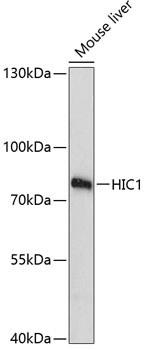-
Product Name
HIC1 Polyclonal Antibody
- Documents
-
Description
Polyclonal antibody to HIC1
-
Tested applications
WB
-
Species reactivity
Mouse
-
Alternative names
HIC1 antibody; ZBTB29 antibody; ZNF901 antibody; hic-1 antibody; hypermethylated in cancer 1 protein antibody
-
Isotype
Rabbit IgG
-
Preparation
Antigen: Recombinant fusion protein containing a sequence corresponding to amino acids 180-430 of human HIC1 (NP_001091672.1).
-
Clonality
Polyclonal
-
Formulation
PBS with 0.02% sodium azide, 50% glycerol, pH7.3.
-
Storage instructions
Store at -20℃. Avoid freeze / thaw cycles.
-
Applications
WB 1:500 - 1:2000
-
Validations

Western blot - HIC1 Polyclonal Antibody
Western blot analysis of extracts of mouse liver, using HIC1 antibody at 1:3000 dilution.Secondary antibody: HRP Goat Anti-Rabbit IgG (H+L) at 1:10000 dilution.Lysates/proteins: 25ug per lane.Blocking buffer: 3% nonfat dry milk in TBST.Detection: ECL Enhanced Kit .Exposure time: 90s.
-
Background
Transcriptional repressor. Recognizes and binds to the consensus sequence '5-[CG]NG[CG]GGGCA[CA]CC-3'. May act as a tumor suppressor. May be involved in development of head, face, limbs and ventral body wall. Involved in down-regulation of SIRT1 and thereby is involved in regulation of p53/TP53-dependent apoptotic DNA-damage responses. The specific target gene promoter association seems to be depend on corepressors, such as CTBP1 or CTBP2 and MTA1. The regulation of SIRT1 transcription in response to nutrient deprivation seems to involve CTBP1. In cooperation with MTA1 (indicative for an association with the NuRD complex) represses transcription from CCND1/cyclin-D1 and CDKN1C/p57Kip2 specifically in quiescent cells. Involved in regulation of the Wnt signaling pathway probably by association with TCF7L2 and preventing TCF7L2 and CTNNB1 association with promoters of TCF-responsive genes. Seems to repress transcription from E2F1 and ATOH1 which involves ARID1A, indicative for the participation of a distinct SWI/SNF-type chromatin-remodeling complex. Probably represses transcription from ACKR3, FGFBP1 and EFNA1.
Related Products / Services
Please note: All products are "FOR RESEARCH USE ONLY AND ARE NOT INTENDED FOR DIAGNOSTIC OR THERAPEUTIC USE"
